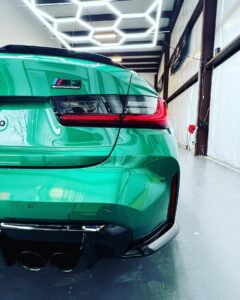An automotive paint correction is a process used by professionals to restore a vehicle’s paint to its original appearance. This process is often necessary to remove imperfections such as swirl marks, light scratches, and other blemishes that can detract from a vehicle’s appearance. There are several different techniques used in paint correction, and each one is designed to address specific issues. We will discuss some of the most common techniques used by professionals.
Fundamentals of Paint Correction
It is made up of multiple stages performed in a predetermined order. The process begins with the use of a clay bar to remove contaminants such as dirt and tar from the paint surface. A mildly abrasive polish is used to level out any imperfections in the paint. An aggressive polish is applied if deep scratches are present that require more aggressive action. A sealant or wax is used to protect the newly corrected paint surface.
Different Techniques Used by Professionals
Washing and decontamination process
Before beginning any paint corrections process, it’s important to thoroughly wash and decontaminate the vehicle’s surface. This involves using a clay bar to remove any surface contaminants that could cause further damage during the correction process. This step is critical to ensuring the correction process is as effective as possible.
Lighter surface abrasions and swirls can be addressed through a single-stage process where only a mild polish is used. This type of correction is typically recommended for vehicles that are in relatively good condition with no major scratches or blemishes.
Machine Polishing
Machine polishing is one of the most common techniques used by professionals. It involves using an electric polisher and polishing pads to remove a thin protective layer of the car’s clear coat or paint from the vehicle’s surface. This technique is designed to remove surface scratches, swirl marks, and other imperfections that can be seen with the naked eye.
Color Sanding
It is a more aggressive technique used to remove heavy scratches and imperfections from a car’s paint job. This technique involves using a wet sanding process to remove the top layer of the clear coat or paint. Color sanding is typically reserved for vehicles with deep scratches or other severe paint damage.

Cutting Compound
Cutting compound is an abrasive polish used to remove deeper scratches and imperfections from a car’s paint. This technique involves using a heavy cutting compound and a microfiber buffing pad to remove the damaged paint or clear coat. This process can be effective, but it should be used with caution as it can also remove a significant amount of paint from the vehicle’s surface.
Polishing Process
Polishing is a more gentle technique used to remove minor scratches and imperfections from a vehicle’s paint. This process involves using fine polish and a polishing pad to remove a thin layer of the vehicle’s clear coat or paint. Polishing can also be used to restore the vehicle’s appearance after a more aggressive paint correction process. A machine polisher is often used to achieve the best results.
Ceramic Coatings and Paint Protection Film
Once the paint correction process is complete, many professionals will apply a protective coating to the vehicle’s surface. Ceramic coating and paint protection film are two popular options that can provide long-lasting protection against fine scratches, bird droppings, and other contaminants. These protective layers can help to maintain the vehicle’s appearance and reduce the need for future paint correction techniques.
Proper Maintenance
Proper maintenance is critical to ensuring the results of the paint correction process last as long as possible. This includes regular washing and waxing, as well as avoiding environmental factors that can damage the vehicle’s paint job, such as tree sap and bird droppings.
Paint correction is a delicate process, and it’s important to understand the different techniques used by professionals in order to achieve the best results. Washing, decontamination, machine polishing, color sanding, cutting compound, and polishing are all common techniques that can be used to restore a vehicle’s appearance. Ceramic coatings and paint protection films can be applied to provide long-lasting protection against future damage.
Proper maintenance is key to ensuring the results of the paint correction process last as long as possible. With the right tools and techniques, professionals can help you get your vehicle’s finish looking new again!
Frequently Asked Questions
Is paint correction just polish?
No, paint correction involves a series of techniques used to restore a vehicle’s appearance. This process may include washing and decontamination, machine polishing, color sanding, cutting compound, and polishing. A protective coating, such as a ceramic coating or paint protection film, can be applied to provide long-term protection against future damage.
What color temperature is best for paint correction?
The ideal color temperature for paint correction varies depending on the particular vehicle and the desired results. A warmer (3000–4000K) color temperature is typically used to enhance the gloss of black or dark colors, while cooler (5000–6000K) temperatures may be used to bring out more depth in light colors.
Do you do paint corrections before or after washing?
The paint correction process should always be done before any washing or decontamination. This helps to ensure that the process is as effective as possible and prevents dirt, grime, and other contaminants from getting stuck in the grooves of the paint. Once the paint has been corrected, it can be washed and waxed to help protect the finish.


